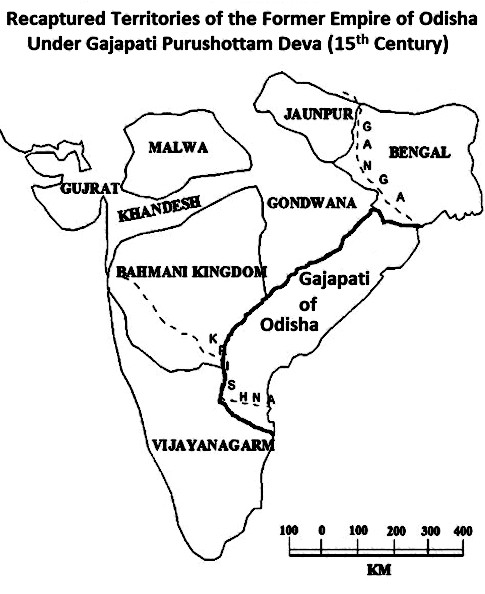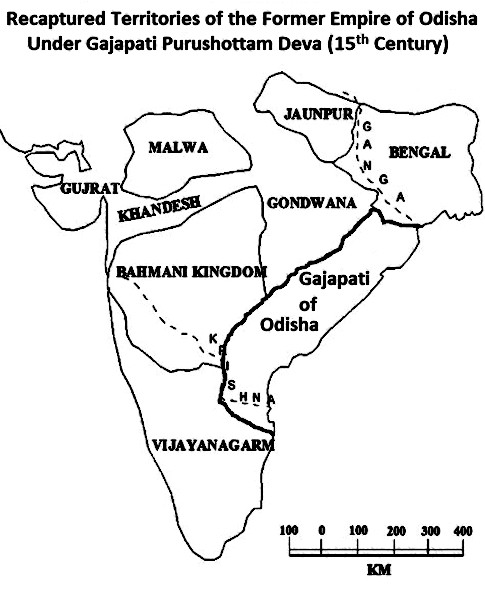The contribution of Odisha into the history of India may be few but highly glorious. Recalling the chapters of history, one can trace back to the prime aspects of ancient Odisha and its administration. The royal past of Odisha signifies courage, sacrifice and loyalty. The brave heart Kings of Odisha (formerly known as Utkala or Kalinga) once blew their blood to protect the soil. They fought with courage and wrote the history with all their efforts.
Bira Pratap Purushottama Deva, the Gajapati King of Puri, is one among the greatest Kings of Odisha. Even if he got the throne from his father, but his bravery and worthiness stands him high above all. The Suryavanshi Gajapati King was one of a unique personalities in varied aspects like multi-dimensional, original and effective power.
From conquering the lost territories of his father to the famous expedition of Kanchi, Purishottama Deva’s courageous ruling period is an inspiring tale to tell.
Getting The Throne
Purishottama Deva ruled Odisha from 1467 to 1497 A.D under the Gajapati dynasty. His father Gajapati Kalpilendra Deva had two sons. The elder son Hamvira Deva was unselected for the throne. Kapilendra Gajapati probably thought Purushottama would be the fit for the position and for fulfilling his wish of conquering a huge empire like Vijayanagaram.
One of the reasons from other sources mentions that Purushottama’s mother was a Phula-Vivahi wife (a wife having a position between queens and concubines). Since the legitimate claim of Hamvira to the throne of Odisha was relegated to back-ground, he proceeded to settle his score with Purushottama Deva.
This brought jealousy in the mind of Hamvira Deva and he was always in quest of a chance to trouble Purushottama.
Rivalry with Hamvira Deva
Hamvira seeking the help of Bahamani King Muhammad Shah III went on to attack the Gajapati Kingdom in the south.
Muhammad Shah sent his associate Malika Hussain Bheiry on his behalf to help Hamvira in the campaign. Hamvira with the help from Muhammad Shah occupied Kondapalli and then proceeded to Cuttack. Hamvira was able to defeat Purusottama Deva and occupied most of his territories.
Hamvira Deva continued to rule those territories under the real power of Bahamani kings until Purushottam Deva retrieved all his lost regions back from Hamvira.
Glories of Purushottama
Recovery of Kondavidu and Rajahmundry
Defeating the Bahamanis, Purushottama Deva seized two important states Kondavidu and Rajahmundry. Marching with his royal army, he recaptured the territories.
Recovery of Udayagiri Rajya
Another rivalry of Purushottama Deva was Saluva Narasimha Deva Ray. The latter had captured Udayagiri Rajya which was earlier under the possession of Kapilendra Deva. Purushottama was successful in defeating Saluva Narasimha and his freedom was dealt with by the surrender of Udayagiri.
According to the Sanskrit epic Prabodhachandrodaya, in the conquest of Udayagiri Purusottamadeva was helped by Vira Vasava or Basava Bhupathi.
History states that Purushottam had to face defeat for the first time when he went on conquering Udayagiri. It was his second attempt when he won over King Saluva Narasimha Deva. After conquering the states of Saluva Narasimha, King Purushottama Deva desired to marry Princess Padmavati. Some texts also describe that there was love between Purushottam Deva and Padmavati. This turns into a famous legend which goes as follows.
You can read our another post on The Leaning Temple of Huma: A Unique Architectural Wonder
The Kanchi Expedition Or Padmavati Episode
Padmavati was the daughter of Saluva Narasimha, the ruler of Kanchi. King Purushottama had a desire to marry him. Also, Saluva Narasimha had given his permission for the marriage. But when he later visited Puri, he saw Purushottama performering Chherapahanra. Chhera Pahanra is one of the traditions being observed from the ancestral period in Puri.
It is the tradition of sweeping away the dirt before the cars of Gods with golden broomsticks during the car-festival. The Kings of Gajapati dynasty dedicated their lives before Lord Jagannath. They were like slaves before the Lord. But Saluva mistook the incident and denied to offer his daughter to a sweeper.
This insult worked like a humiliation to Purushottama. His army led a march towards Kanchi, but was defeated at first. After returning from the war defeated, he fell under the feet of Lord Jagannath and cried. He prayed to the Lord to bless him with courage. That night itself, Lord Jagannath came in his dream and told Purushottama to march for Kanchi once again. The Lord also promised to help the king this time.
With new craze and enthusiasm, Purushottama marched towards the South once again. During his march, he had to stop at a place near Chilika. The stopper was a milkmaid, named Manika. She cried at the King that two young soldiers passed through that way. They rode on black and white horses. The former having black and the later having white complexion, also drank all her curd and paid nothing. When she asked for the payment, the two soldiers handed her a finger ring and told her that our King was coming behind. He will pay you on our behalf.
Looking at the ring, King Purushottama realised that the two soldiers were no less than Lord Jagannatha and his elder brother Lord Balabhadra, who promised him to help. The King’s heart felt with joy. His eyes were filled but with joy. When he told Manika about all these, Manika was also mesmerized to have seen the Lord in reality.
The place where Manika stood and the surrounding area was named by the King as Manika Patana afterwards.

The King of Ranchi was defeated in the war. Purushottama Deva brought Padmavati along with many idols from Kanchi including a famous statue of Lord Ganesh. But he had been insulted so badly by Saluva that he instructed his minister to give the hand of Padmavati to a Chandala (born in a lower caste and one who performs sweeping). He did this inorder to cool down his anger.
The minister was clever. So he took Padmavati to his house and kept her as a daughter. The minister waited for the right time. During the next Ratha Yatra, while the King was sweeping the chariot, he took Padmavati and asked her to garland Purushottama Deva. In question to the King’s answer, the minister answered that no one is a better option as a Chandala (as the King was doing the work of a Chandala at that time) than Purushottama. Then the King accepted Padmavati.
This is one of the famous legends. Many historians do not agree to the same.
Achievements of Purushottama
King Purusottama Deva played his part as a great diplomat and during his reign implemented the following.
- Abolition of Chaukidari tax which was imposed previously on the Brahmins
- Renewal of old grants to them as is evidenced from his Jagannath temple inscription
- Capitalisation of the favour of his father Kapilendradeva, the divine blessings of God Jagannath and the sympathy of the Brahmins to legitimise his position on the Suryavamsi throne
- Like his father Kapilendradeva, Purusottama was an opportunist. Taking the weakness of the Bahamani Kingdom, he attacked it and recovered the lost Rajahmundry region and Kondavidu fort.
- Recovered Udayagiri-rajya from Saluva Narasimha
- Besides giving grant to the Brahmins, he also made arrangements for new provisions in the Jagannath temple
- He made gifts for the personal enjoyment and stage entertainments of the Siva deity at Potavara
- He also gave away the revenue of a village to meet the expenses of offerings to the Simmachalam temple.
Purushottama In Person
King Purushottama Deva was a liberal man. During his reign, the state of Odisha remained peaceful. Less or no war happened to be the case. The subjects at his times enjoyed peace and prosperity.
He was a King who took the responsibility on his shoulder as and when required. Apart from his military skills, he was also a great scholar as well as patron of literature. Some of his compositions include Abhinava Gitagovinda, Nama Malika,, Mukti Chintamani, Abhinava Venisamhara, Gopalapuja Paddhati, Durgotsav, Bishnu Bhakti, Kaladruma, Sanskrit Dictionary called Trikanda Kosha.
Purusottamadeva also had a great interest in building and constructions. He built the temple of Sundara Madhava at Purusottampur in the Ganjam district.
During his reign period, Tamma Raya, one of his vassals installed an image of Gopala Krishna at Udayagiri which Krishnadevaraya had taken away to Vijayanagara after his conquest on Udayagiri-rajya.
More: Wanted to download Odishashop.com visit here
Conclusion
Purushottama Deva was the first monarch of Utkal who declared himself as the deputy of Lord Jagannatha. As the King had a number of elephants in his army, he was called as Gajapati King. The tradition continues even today.
The King of Puri is called as Gajapati who does the sweeping of the chariot of Lord Jagannath during the Car Festival. The only thing is, there is no King’s rule today as we live in a democratic and federal state.
Sources
- History Of Odisha, 1930, Vol 1. From the Earliest Times to the British Period. pgs 314, 315, 316, 317
- Kings of Puri, http://www.speakingtree.in

